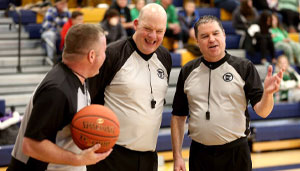It’s every coach’s worst nightmare. Practice has begun and one of the athletes is late. We teach our athletes honesty, discipline, and respect. Practice then begins without the absent player; however, 10 minutes into practice an administrator walks in and you have to delegate your duties to your assistants. The administrator relays why the student is not there and it shakes you to the core as you realize you, your team, and the community will never be the same. Being a coach is a challenge even in the best of circumstances; however, coaches should be prepared for every eventuality, no matter how remote the possibility. Unexpected outcomes are a natural part of games, but we also need to prepare ourselves for the unexpected outcomes of life and be there for our students in times of tragedy. These circumstances could include catastrophic injury, the death of family or teammates, and even the catastrophe of natural disaster through fire or weather related events. More times than not, our athletes and entire communities will watch and look for direction from our coaches to find out the best ways to handle these situations.
Be Available to Listen & Provide Adaptable Activity
Being a student athlete in a time of distress can be challenging. Society sends mixed messages. Athletes are supposed to be strong, overcome adversity, and be leaders to others. It is because of these societal messages that some athletes may respond by bottling up their emotions. In every sense of the word, they are vulnerable and athletic competition is partly about exploiting the vulnerabilities of our opponents. It is no wonder then that our student-athletes respond to this paradox by shutting down.
Coaches need to be vigilant about addressing catastrophe with student-athletes, explaining the grieving process and even sharing their own personal struggles. A coach revealing his or her own struggles is not a sign of weakness, but of leadership – an example of how to deal with catastrophe and still progress through life. This is not to be confused with being a metaphorical island of strength. Coaches also need to recognize that school athletic directors and administration are there as a team to help support. They have the resources to bring context to student-athletes and help them heal. Most importantly, coaches need to be able to open lines of communication with their athletes and listen. Student-athletes that can speak out to a vested coach will strengthen their bonds and take the first steps in recovering from catastrophe.
Coaches also need to be aware that an athlete’s connection to a sport may be the only routine they have in their life. It’s important that we provide a supportive environment that allows students to participate in a way that supports their recovery. Some athletes may want to use their athletic participation as a release from the tension in their lives while others may want the emotional support provided by their team bonds. It’s important for coaches to listen and be observant about what methods will best help our athletes recover from catastrophe.
Be Calm and Communicate with your Administrative Team
When faced with catastrophe, it is important for coaches to keep open lines of communication with the athletic director and administrative team. Whether a team member faces the loss of a family member, team member, or even destruction of a family home, coaches don’t need to shoulder the weight of such challenging times alone. Many schools have counseling resources to help both students and coaches recover from unsettling situations. In addition, the role of administration is to support the coaching staff to succeed. Coaches must be willing to keep administration informed, ask, and allow for help when needed.
Give Direction to Heal and Inspire Team to Unifying Action
Powerful emotions are embedded in catastrophe. During these times, coaches and students realize their own mortality and take inventory of what is most important to them. Overwhelmingly, they will find solace in the bonds they have developed with their teammates and coaches. As leaders of student-athletes, coaches can channel these emotions positively with recovery efforts for community, funding drives for teammates or families in need, or even dedications of tournaments and/or seasons to give further direction to their teams. It is imperative that these types of activities do not focus on outcome. Finite game scores or numbers of wins in a season cannot be controlled and such goals can be reckless in helping student-athletes recover from trauma if students do not reach these expectations. On the other hand, dedicating individual tournaments or seasons to individuals have a cumulative effect on healing as athletes can focus on playing for their own motivations and focus on strengthening the bonds with their current teammates and coaches.
Final Thoughts
Catastrophic times are something coaches hope they never have to face; however, when coaches focus on listening to the student-athletes, utilize their resources provided by the school administration, and remain calm, they can serve as excellent leaders. Furthermore, coaches can influence teams by creating appropriate goals for student-athletes to better ensure their ability to recover. In taking these steps, students will better learn how to handle catastrophe and build stronger bonds with their team.
Steve Amaro
Steve Amaro has been a USPTA certified tennis coach, athletic director (CMAA), and English teacher at Freedom High School in Oakley, California, for the past 13 years. He recently received his Ph.D. in Educational Leadership from St. Mary’s College in Moraga, California. A current member of the NFHS Coaches Publications Committee and the NIAAA Accreditation Committees, he is also the president of the North Coast Section Athletic Directors Association, a member of the California Interscholastic Federation (CIF) Athletic Administrator Advisory Committee, a representative at the section level of the California Coaches Association (CCA) and an NIAAA LTI instructor at the state level.
Most Recent Articles
- nfhs news NFHS Learning Center Delivers 25 Millionth Course
- Track & Field/Cross Country article Effective Communication with Athletes and Coaches
- nfhs news Player Equipment Changes Highlight 2025 High School Football Rules Revisions
- Player Equipment Changes Highlight 2025 High School Football Rules Revisions
- nfhs news Judgment Call on Second Contact Eliminated in High School Volleyball






